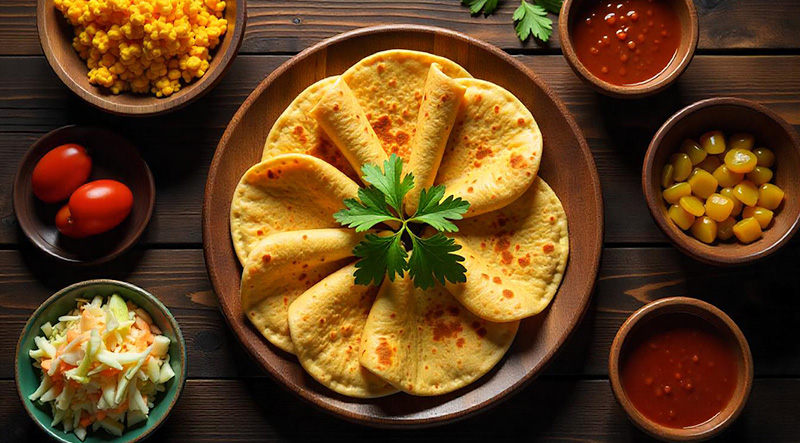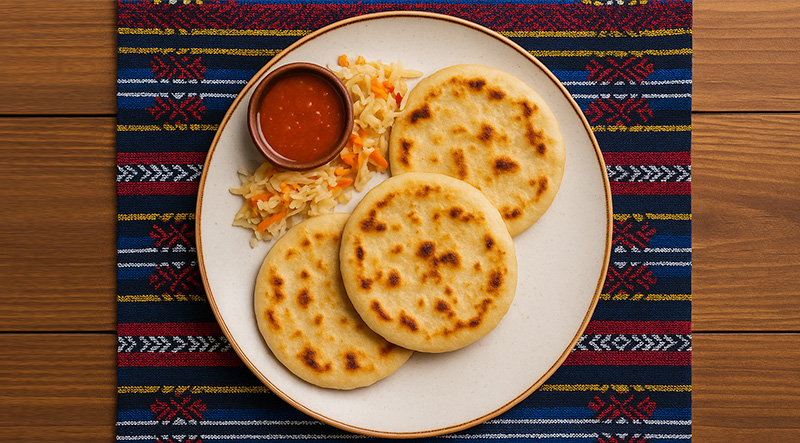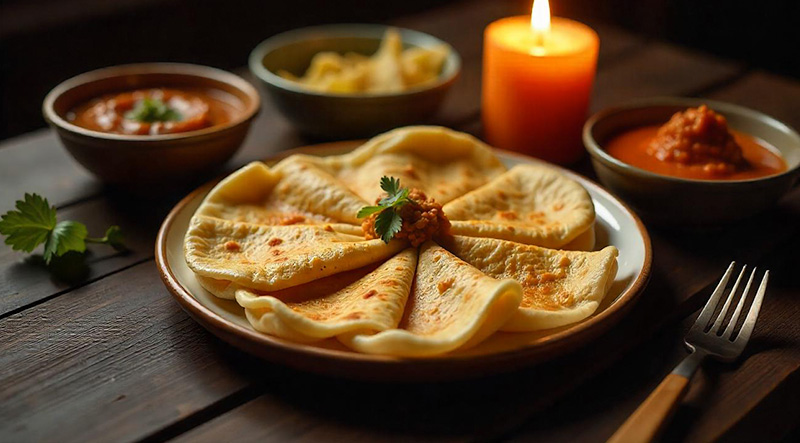Bite into the heart of El Salvador with the irresistible **pupusa**, a golden, griddled corn tortilla stuffed with melty cheese, savory beans, spiced pork, or all three in one glorious mouthful. Crispy on the outside and warm and gooey within, pupusas are the ultimate comfort food—handmade with love and always served with a side of tangy curtido (pickled cabbage slaw) and smooth tomato salsa. Simple, satisfying, and proudly Salvadoran, this national dish is more than a meal—it’s a cultural icon you can eat with your hands and your heart. Read More...
Pupusa – The Proud and Flavorful History of El Salvador’s National Dish:
In the vibrant culinary landscape of Central America, few dishes are as iconic and beloved as the pupusa. This thick, handmade corn tortilla stuffed with cheese, beans, meat, or vegetables is not just El Salvador’s most popular street food—it’s a symbol of national identity, tradition, and resilience. Declared the official national dish in 2005, the pupusa is far more than a snack; it is the edible essence of Salvadoran culture, passed down through generations and celebrated across borders.
Ancient Origins: A Pre-Columbian Invention:
The history of the pupusa stretches back over 2,000 years, with roots in the Pipil people, an indigenous group that once inhabited the western and central regions of present-day El Salvador. Archaeological findings—including tools used for grinding corn and shaping masa—support the theory that pupusas were a regular part of the pre-Columbian diet. Back then, they were made primarily with ground maize dough (masa de maíz) and filled with squash, herbs, or beans.
The word “pupusa” is believed to derive from Nahuat, the language of the Pipil, possibly from “pupusawa”, meaning “swollen” or “stuffed.” This early version of the dish was not only portable and filling but made entirely with locally grown ingredients, making it ideal for agrarian and nomadic lifestyles.
Spanish Influence and Evolution:
With the arrival of the Spanish colonizers in the 16th century, the pupusa began to evolve. European-introduced ingredients such as pork and cheese gradually made their way into the dish, enhancing its flavor and variety. Over time, Salvadorans began to craft more elaborate fillings like chicharrón (ground, seasoned pork), queso con loroco (cheese with edible flowers), and revueltas (a mixture of cheese, beans, and pork), which are now among the most popular pupusa varieties.
The griddle-cooked method—a distinguishing feature of pupusas—remained largely unchanged, maintaining its rustic, homespun appeal.
Pupusas as a Cultural Backbone:
For centuries, pupusas remained a cherished staple in rural Salvadoran homes. Women traditionally made them by hand, often in the early morning, flattening the dough and stuffing it before cooking them on a clay or metal griddle called a comal. Families would gather around fresh pupusas with a side of curtido (fermented cabbage slaw) and salsa roja, making the meal as much about togetherness as nourishment.
Despite years of political unrest and economic hardship in El Salvador, the pupusa endured—served in homes, mercados, and roadside stands. For many, it became a symbol of comfort and cultural continuity during turbulent times.
Official Recognition and National Pride:
In 2005, El Salvador’s Legislative Assembly formally declared the pupusa the national dish, and in 2006, they established “Día Nacional de la Pupusa” (National Pupusa Day), celebrated every second Sunday of November. This annual event features massive pupusa cookouts, contests, and festivals, including record-breaking attempts like the creation of the world’s largest pupusa.
This official recognition further cemented the pupusa’s status as more than food—it is a national emblem, a culinary ambassador for Salvadoran culture around the world.
A Global Staple:
As Salvadoran communities have expanded across North and Central America, so too has the pupusa. Cities like Los Angeles, Washington D.C., and Houston are now home to hundreds of pupuserías, where both Salvadorans and food lovers of all backgrounds flock to enjoy this delicious dish. With each order of pupusas, immigrants and descendants reconnect with their roots and proudly share a piece of their homeland.
The pupusa has even influenced other cultures, leading to fusion versions that include vegan, gluten-free, or gourmet varieties—yet the core of the dish remains true to its origins: a warm, filled tortilla made by hand, shared with love.
Conclusion: A Bite of Heritage:
Whether enjoyed on a street corner in San Salvador or at a pop-up stall in Los Angeles, pupusas carry centuries of history, flavor, and meaning in each bite. They represent more than sustenance—they reflect a people’s history, creativity, and pride. From indigenous invention to national treasure, the story of the pupusa is one of survival, evolution, and cultural triumph.
Prepare the Filling:
Make the Dough:

Form the Pupusas:

Cook the Pupusas:

Serve Immediately:

Tips & Notes:
With their crispy crust, warm cheesy centers, and tangy slaw on the side, pupusas are more than just a meal—they’re a hand-sized celebration of Salvadoran heritage.
The total preparation and cooking time for pupusas is approximately 1 hour. Preparing the fillings—such as cooking and shredding pork, heating beans, or grating cheese—takes about 20 minutes. Mixing and kneading the masa dough requires another 10 minutes, followed by forming and stuffing the pupusas, which can take around 15–20 minutes depending on experience. Cooking each batch on a hot griddle takes 2–3 minutes per side, totaling about 15–20 minutes for all depending on the pan size. With a steady workflow, the entire process from start to finish can be completed in about 60 minutes, making pupusas a deliciously doable traditional dish.
A single pupusa from the recipe provided contains approximately 250 to 350 calories, depending on the filling. The masa dough itself contributes around 140–160 calories per pupusa. A cheese-only filling adds about 80–100 calories, while refried beans or chicharrón can range from 60 to 100 calories per portion, depending on the fat content. Mixed fillings like revueltas (beans, cheese, and pork) tend to be on the higher end. Traditional sides like curtido (pickled cabbage slaw) are very low in calories (under 30), while salsa roja adds minimal calories. With sides, a full serving of two pupusas typically ranges between 500 to 700 calories.







